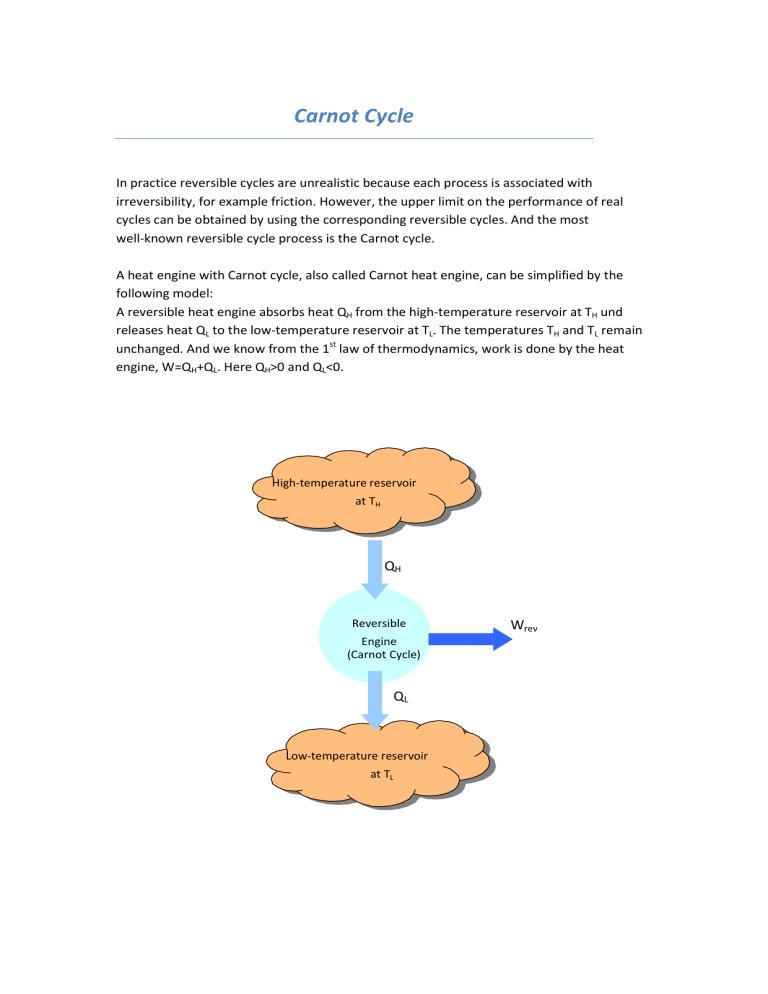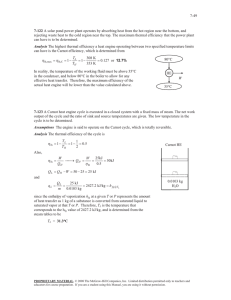Carnot Cycle - WordPress.com

Carnot Cycle
In practice reversible cycles are unrealistic because each process is associated with irreversibility, for example friction. However, the upper limit on the performance of real cycles can be obtained by using the corresponding reversible cycles. And the most well-known reversible cycle process is the Carnot cycle.
A heat engine with Carnot cycle, also called Carnot heat engine, can be simplified by the following model:
A reversible heat engine absorbs heat Q
H
from the high-temperature reservoir at T
H
und releases heat Q
L
to the low-temperature reservoir at T
L
. The temperatures T
H
and T
L
remain unchanged. And we know from the 1 st
law of thermodynamics, work is done by the heat engine, W=Q
H
+Q
L
. Here Q
H
>0 and Q
L
<0.
High-temperature reservoir at T
H
Q
H
Reversible
Engine
(Carnot Cycle)
Q
L
Low-temperature reservoir at T
L
W rev
The Carnot cycle in this heat engine consists of two isentropic and two isothermal processes. p
1
Q
H
2
4
3
Q
L
0 v
Process 1-2: Reversible Isothermal Expansion (T
H
=const)
During this process, heat is absorbed by the gas. Gas expands reversibly at the constant temperature T
H
.
Process 2-3: Reversible Adiabatic (Isentropic) Expansion
This process is isentropic. The engine is perfect insulated so that no heat is lost and absorbed.
Gas continues expanding slowly until the temperature drops from T
H
to T
L
.
Process 3-4: Reversible Isothermal Compression (T
L
=const)
After gas reaches the low temperature T
L
, some external force is applied on the engine in order that gas can be compressed. Since the temperature remains constant at T
L
, no change of internal energy of gas occurs, if we assume that gas is ideal gas. Knowing from the 1 st
law of thermodynamics, we obtain a conclusion that heat must be transferred from engine to low-temperature reservoir.
Process 4-1: Reversible Adiabatic (Isentropic) Expansion
This process is isentropic. The engine is perfect insulated so that no heat is lost and absorbed.
Gas continues being compressed slowly until the temperature rises from T
L
to T
H
. The process comes to an end when reaching its initial state (state 1).
The thermal efficiency of the Carnot heat engine can be calculated with the general expression:
å h
,
1
T
T
H
1
T
L
4
Q
H
2
3
Q
L
0 s
From the T-s-diagramm, we obtain:
Q zu
=Q
H
=T
H
Q ab
=Q
L
= T
L
S
1-2
= - S
3-4
S
1-2
S
3-4
Therefore h
,
1
D
D
1
This equation is also referred to as Carnot efficiency.
According to the Carnot efficiency, we can also draw the following conclusions:
1. The Carnot efficiency only depends on the highest and lowest temperature.
2. If we want to increase the Carnot efficiency, we can increase the highest temperature T
H
or reduce the lowest temperature T
L
.
3. The efficiency of a Carnot heat engine is always smaller than 1. Only when T
H
®¥ or
T
L
®0 could
4. For T
H
=T
L th,C
®1. But both methods are impossible in the prac ce.
we have th,C
=0. That means, if we only one reservoir, system is not able to undergo a cyclic process and, of course, no work can be done.
As mentioned above, the Carnot cycle is a reversible process which delivers the most work output for a heat engine operating between the same temperature limits. Hence, if a heat engine has the thermal efficiency of
th
< th,C th
, then:
: irreversible heat engine
th
= th,C
: reversible heat engine
th
> th,C
: unrealistic heat engine






